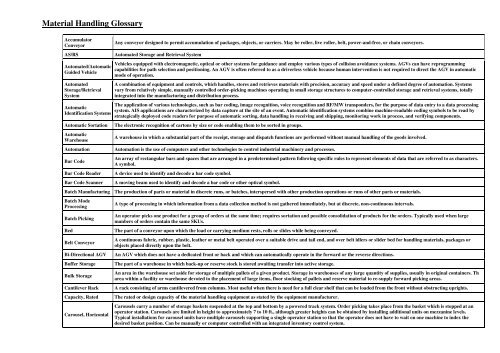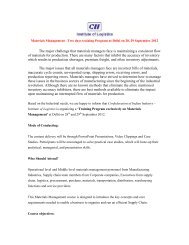Material Handling Glossary - CII Institute of Logistics
Material Handling Glossary - CII Institute of Logistics
Material Handling Glossary - CII Institute of Logistics
You also want an ePaper? Increase the reach of your titles
YUMPU automatically turns print PDFs into web optimized ePapers that Google loves.
<strong>Material</strong> <strong>Handling</strong> <strong>Glossary</strong>AccumulatorConveyorAny conveyor designed to permit accumulation <strong>of</strong> packages, objects, or carriers. May be roller, live roller, belt, power-and-free, or chain conveyors.AS/RSAutomated/AutomaticGuided VehicleAutomatedStorage/RetrievalSystemAutomaticIdentification SystemsAutomatic SortationAutomaticWarehouseAutomationBar CodeBar Code ReaderBar Code ScannerAutomated Storage and Retrieval SystemVehicles equipped with electromagnetic, optical or other systems for guidance and employ various types <strong>of</strong> collision avoidance systems. AGVs can have reprogrammingcapabilities for path selection and positioning. An AGV is <strong>of</strong>ten referred to as a driverless vehicle because human intervention is not required to direct the AGV in automaticmode <strong>of</strong> operation.A combination <strong>of</strong> equipment and controls, which handles, stores and retrieves materials with precision, accuracy and speed under a defined degree <strong>of</strong> automation. Systemsvary from relatively simple, manually controlled order-picking machines operating in small storage structures to computer-controlled storage and retrieval systems, totallyintegrated into the manufacturing and distribution process.The application <strong>of</strong> various technologies, such as bar coding, image recognition, voice recognition and RF/MW transponders, for the purpose <strong>of</strong> data entry to a data processingsystem. AIS applications are characterized by data capture at the site <strong>of</strong> an event. Automatic identification systems combine machine-readable coding symbols to be read bystrategically deployed code readers for purpose <strong>of</strong> automatic sorting, data handling in receiving and shipping, monitoring work in process, and verifying components.The electronic recognition <strong>of</strong> cartons by size or code enabling them to be sorted in groups.A warehouse in which a substantial part <strong>of</strong> the receipt, storage and dispatch functions are performed without manual handling <strong>of</strong> the goods involved.Automation is the use <strong>of</strong> computers and other technologies to control industrial machinery and processes.An array <strong>of</strong> rectangular bars and spaces that are arranged in a predetermined pattern following specific rules to represent elements <strong>of</strong> data that are referred to as characters.A symbol.A device used to identify and decode a bar code symbol.A moving beam used to identify and decode a bar code or other optical symbol.Batch Manufacturing The production <strong>of</strong> parts or material in discrete runs, or batches, interspersed with other production operations or runs <strong>of</strong> other parts or materials.Batch ModeProcessingBatch PickingBedBelt ConveyorBi-Directional AGVBuffer StorageBulk StorageCantilever RackCapacity, RatedCarousel, HorizontalA type <strong>of</strong> processing in which information from a data collection method is not gathered immediately, but at discrete, non-continuous intervals.An operator picks one product for a group <strong>of</strong> orders at the same time; requires sortation and possible consolidation <strong>of</strong> products for the orders. Typically used when largenumbers <strong>of</strong> orders contain the same SKUs.The part <strong>of</strong> a conveyor upon which the load or carrying medium rests, rolls or slides while being conveyed.A continuous fabric, rubber, plastic, leather or metal belt operated over a suitable drive and tail end, and over belt idlers or slider bed for handling materials, packages orobjects placed directly upon the belt.An AGV which does not have a dedicated front or back and which can automatically operate in the forward or the reverse directions.The part <strong>of</strong> a warehouse in which back-up or reserve stock is stored awaiting transfer into active storage.An area in the warehouse set aside for storage <strong>of</strong> multiple pallets <strong>of</strong> a given product. Storage in warehouses <strong>of</strong> any large quantity <strong>of</strong> supplies, usually in original containers. Thearea within a facility or warehouse devoted to the placement <strong>of</strong> large items, floor stocking <strong>of</strong> pallets and reserve material to re-supply forward picking areas.A rack consisting <strong>of</strong> arms cantilevered from columns. Most useful when there is need for a full clear shelf that can be loaded from the front without obstructing uprights.The rated or design capacity <strong>of</strong> the material handling equipment as stated by the equipment manufacturer.Carousels carry a number <strong>of</strong> storage baskets suspended at the top and bottom by a powered track system. Order picking takes place from the basket which is stopped at anoperator station. Carousels are limited in height to approximately 7 to 10 ft., although greater heights can be obtained by installing additional units on mezzanine levels.Typical installations for carousel units have multiple carousels supporting a single operator station so that the operator does not have to wait on one machine to index thedesired basket position. Can be manually or computer controlled with an integrated inventory control system.
Carousel, VerticalCellChain ConveyorClear OverheadHeightClear Stacking HeightCluster PickingComputer-AidedDesignComputer SimulationControl SystemControllerConverging SectionConveyorConveyor BeltConveyor ChainConveyor GuardConveyor WidthSimilar principal to Horizontal Carousel, but operates vertically with a gimbaled tray suspended between the traction chains.A manufacturing unit consisting <strong>of</strong> two or more workstations or machines and the material transport mechanisms and storage buffers that interconnect them.Any conveyor in which one or more chains act as the conveying element. A British term for trolley conveyor.Distance from the floor to the lowest overhead obstruction (e.g., ceiling truss, sprinkler heads, heating pipes, etc.).(Working Head Room) The distance from the floor to a point usually a least 18 in. below the lowest overhead obstruction. The clearance required between the top <strong>of</strong> the highesload and the lowest overhead obstruction will vary depending upon local fire codes.An operator picks to containers for multiple orders and will pick a product(s) for each order during a single pass through the pick area. Typically used when the total cube <strong>of</strong>multiple orders can be manually transported.The use <strong>of</strong> an interactive-terminal workstation, usually with graphics capability, to automate the design <strong>of</strong> products and projects. CAD includes functions such as drafting.The creation <strong>of</strong> a mathematical model, representing the operation under study, for purposes <strong>of</strong> testing the implications <strong>of</strong> possible operating scenarios without having toimplement them. See Simulation.A hardware/s<strong>of</strong>tware system that has as it's primary function the collection and analysis <strong>of</strong> feedback from a given set <strong>of</strong> functions for the purpose <strong>of</strong> controlling these functionsControl may be implemented by monitoring and/or systematically modifying parameters or policies used in those functions, or by preparing control reports that initiate usefulaction with respect to significant deviations and expectations.• 1. A device or group <strong>of</strong> devices which serves to govern in some predetermined manner the power delivered to a motor to which it is connected.• 2. An electromechanical device or assembly <strong>of</strong> devices for starting, stopping, accelerating, decelerating a conveyor drive, or which serves to govern in some predeterminedmanner the electric power delivered to a drive.A section <strong>of</strong> roller or wheel conveyor where two conveyors meet and merge into one conveyor.A horizontal, inclined or vertical device used to move or transport bulk materials, packages or objects in a path predetermined by design <strong>of</strong> the device and having points <strong>of</strong>loading and discharge fixed, or selective; included are vertical reciprocating and inclined reciprocating conveyor.A belt used to carry materials and transmit the power required to move the load being conveyed.A chain used to drive the roller in a roller conveyor.A structure mounted below the conveyor path to protect personnel and equipment below from falling material or packages.In unit handling conveyor, the dimensions inside-to-inside <strong>of</strong> frame rails.Crab Movement <strong>of</strong> an AGV in the lateral (sideways) direction, from 0° -90°.CraneCross-Belt SorterCubeCube UtilizationCurved BeltConveyorCycle TimeDecision PointDedicated AislesA machine for lifting and lowering a load and moving it horizontally, with the housing mechanism an integral part <strong>of</strong> the machine.High-speed sortation conveyor for small items, to 18 in. by 18 in., that powers the belt to transfer each item into a container or chute.• 1. The product by length by width by depth.• 2. The total area inside a truck trailer. The length times the width times the height <strong>of</strong> the trailer is the cube space.• 3. The true storage capacity <strong>of</strong> a building: L x W x H.The ratio <strong>of</strong> space occupied with material to total cubic space available, usually expressed as a percentage.A unit load belt conveyor usually operating horizontally through 90° or 180° turn.• 1. Time for a material handling machine to perform one cycle (pick, store, move).• 2. The total time for a process from start to completion.Branch(es) in the guide path or conveyor path (i.e., intersections, spurs).An aisle in a warehouse serving only one function. This aisle can be for order selection, product storage, or both.
Dedicated StorageDiscrete PickingDistributionDistribution CenterDockDock-To-Stock TimeDouble-Deep RacksDouble-Deep AS/RSDwell TimeEDIEnd-Of-Aisle PickingSystemExtendable ConveyorFIFOFirst-In, First-OutFixed Beam Bar CodeReader/ScannerFlat Belt ConveyorFlexibleManufacturingSystem (FMS)Floor Loading TrucksFloor LoadingFloor StackingFlow AnalysisFlow Process ChartFlow RackGuidepathA storage policy (usually contrasted with random storage) in which a warehouse location is dedicated to house a specific SKU or SKUs.An operator picks one order, one product at a time. Typically used when order size, distance traveled, and number <strong>of</strong> total SKUs is small.The broad range <strong>of</strong> activities concerned with efficient movements <strong>of</strong> finished products from the end <strong>of</strong> the production line or receiving dock, to the consumer; in some cases itmay include the movement <strong>of</strong> raw materials from the source <strong>of</strong> the supply to the beginning <strong>of</strong> the production line. These activities include transportation, warehousing,material handling, protective packaging, inventory control, order processing, market and sales forecasting, customer service, and attendant management information systems.Intermediate warehouse(s) where products from different sources are assembled for shipment and distribution to specific customer locations.A platform designed to align the floor <strong>of</strong> a building with the bed <strong>of</strong> a truck trailer.The elapsed time measured for an inbound item from trailer docking to product put away.Usually two rows <strong>of</strong> selective racks, one placed behind the other, on which pallets may be placed two deep by a double-deep reach truck. Fifty percent <strong>of</strong> all loads areimmediately accessible and, in the worst case, it is necessary to remove the front pallet on any level to have access to the one immediately behind it. Applies to a storagerequirement for many pallets <strong>of</strong> few SKUs.Similar to Double-Deep racks with the pallets being stored and retrieved by an Automated Storage/Retrieval Machine.The time spent at the bin front or storage slot or any equipment waiting for a material handling transaction.Electronic Data Interchange. The direct communication <strong>of</strong> data between the computers <strong>of</strong> two companies or institutions.High-density mechanized binnable parts systems such as mini load or carousel units provide dense storage and maximize the use <strong>of</strong> available storage height. These systems areparticularly useful when high transaction rates and large inventory levels result in unacceptably high travel times for man-to-part order picking methods. By delivering thepart to the order picker, operator travel time is eliminated. These systems are also effective in situations requiring additional packaging, checking, or processing which wouldbe impractical to provide on an order-picking industrial truck.Used for packaged materials, objects or units. Conveyor may be one <strong>of</strong> several types including roller, wheel, or belt conveyors. Is constructed so the conveyor may be extendedor shortened within limits to suit operation needs.First-In, First-OutAn inventory valuation method, in which costs <strong>of</strong> material are transferred in chronological order.A bar code reader that uses a stationary beam and relies on the relative motion <strong>of</strong> an item to be read as it passes before the reader. Typically called Fixed Bar Code Reader.A type <strong>of</strong> belt conveyor in which the carrying run <strong>of</strong> the conveyor belt is supported by flat belt idlers or by a flat, slider surface.An arrangement <strong>of</strong> machine tools, capable <strong>of</strong> stand alone operation that are interconnected by a work piece transport system and controlled by a central computer. Oftenconsists <strong>of</strong> an AGV, conveyor or AS/RS delivering work pieces (machine tool pallets) and tools to machines. The transport subsystem, possibly including one or more robots,carries work to the machines or pallets or other interface units so that accurate registration is rapid and automatic. FMS may have a variety <strong>of</strong> parts being processed at onetime.• 1. A technique used for packing a truck in which pallets and stretch film are not used.• 2. Hand carrying (conveyors are frequently used) a load on a truck and shipping the load by leaving it on the trailer floor unprotected.Measure <strong>of</strong> the load bearing capacity <strong>of</strong> a (warehouse) floor, defined in both area (psf) and point loading (psi) for storage rack and machines.The stacking <strong>of</strong> unit loads directly on top <strong>of</strong> each other with the floor as a base.The detailed analysis <strong>of</strong> the flow <strong>of</strong> either workers or material, from place to and/or from operation to operation. The examination seeks reasons for determining how theprogressive travel or the operation may be changed or modified to achieve the utmost economies in both time and material.A graphic, symbolic representation <strong>of</strong> the work performed, or to be performed, on a product as it passes through some or all <strong>of</strong> the stages in the process.• 1. A technique used for packing a truck in which pallets and stretch film are not used.• 2. Hand carrying (conveyors are frequently used) a load on a truck and shipping the load by leaving it on the trailer floor unprotected.Path over which an AGV travels. Often such a path contains a guidewire, tape or painted route. Required for communication with the guidance system.
I/OInput/OutputInventory ControlInventory TurnoverRatioLast-In, First-OutLayoutLIFOLoad CapacityLoad HeightLoad LengthLoad WidthLoading DockPlatform<strong>Logistics</strong>Machine-ReadableManifestManufacturing Cell<strong>Material</strong>(s) <strong>Handling</strong><strong>Material</strong>s ControlMergingMezzanineMini Load AS/RSMonorailMTBFInput/Output• 1. All activities used to move data in and out <strong>of</strong> a processor computer.• 2. Also known as Pickup/Deposit station.In a complete inventory management system, it includes stock levels, stock locations, reorder points, balance-on-hand, item physical description, rotation, etc.Measures the return obtained from inventory investments and provides an indication <strong>of</strong> the movement <strong>of</strong> materials. Usually expressed as the ratio <strong>of</strong> annual sales to averageinventory investment on hand.An inventory valuation method, in which costs are transferred in reverse chronological order.• 1. A floor plan showing assignment <strong>of</strong> gross space for storage operations and supporting functions.• 2. A graphical representation to scale <strong>of</strong> a facility, usually in two dimensions, but sometimes in three.Last-In, First-OutThe maximum total weight that can be handled by material handling equipment without sacrifice <strong>of</strong> any <strong>of</strong> the applicable published specifications <strong>of</strong> the equipment.Maximum overall dimension from the bottom <strong>of</strong> a pallet or load module to the top.Maximum overall dimension <strong>of</strong> a pallet or load module, measured in the direction perpendicular to the length <strong>of</strong> the aisle for conventional fork truck handling. Automatedsystems may store loads with length in parallel to the aisle length. Always note the standard in a warehouse. Load length may exceed the pallet dimension with productoverhang.Maximum overall dimension <strong>of</strong> a pallet or load module and load in the direction parallel to an aisle for conventional fork truck handling, or perpendicular to the aisle forautomated systems. Always check.An area <strong>of</strong> a warehouse or other facility where merchandise is received or shipped. The height <strong>of</strong> the structure is usually designed to conform to the truck bed height on thetruck side <strong>of</strong> a facility, and to rail car bed height at a rail dock.The science <strong>of</strong> planning and carrying out the movement and maintenance <strong>of</strong> operations. Deals with the design and development, acquisition, storage, movement, distribution,maintenance and disposition <strong>of</strong> material.That characteristic <strong>of</strong> printed information that permits the direct transfer <strong>of</strong> information from a printed surface to a data processing system without operator intervention. Barcoding and optical character recognition are technologies <strong>of</strong> machine reading, as are imaging cameras.A document that captures information on the freight carrier, class <strong>of</strong> shipment, shipper, recipient, and other information pertinent to the shipment.A collection <strong>of</strong> machines, grouped together with material handling systems for processing a family <strong>of</strong> parts or assembly.• 1. An aspect <strong>of</strong> materials management relating specifically to the physical transfer <strong>of</strong> materials.• 2. The movement <strong>of</strong> materials (raw materials, scrap, semi-finished and finished) to, through and from productive processes; in warehouses and storage; and in receiving andshipping areas.The function <strong>of</strong> maintaining a constantly available supply <strong>of</strong> raw materials, purchased parts, and supplies needed for production - including requisitioning materials ineconomic quantities at their proper time; also includes receipts, storage, protection, etc.A process <strong>of</strong> bringing together various parts <strong>of</strong> an order, which have been selected in different picking areas (zones). Also known as consolidation.A platform supported with structural members, used for storage or operations; constructed at a height which permits movement <strong>of</strong> people and equipment below.A storage and retrieval concept where materials are accessed by automatically bringing storage containers to an operator. The mini load storage/retrieval machine can be fullyautomated by using a dedicated computer.Describes automated and mechanical transport systems. An elevated conveying system consisting <strong>of</strong> a rail and load-transporting carrier. The rails typically enclose chain,driven by a motor with mechanisms to engage and transport carriers. Automated Electrified Monorail (AEM) and Electrified Monorail Systems (EMS) provide a supportingrail with continuous electrical feeds. The carriers and <strong>of</strong>f-board controls provide responsive flexibility <strong>of</strong> pathing and load-handling including automated loading andunloading.• 1. Mean Time Between Failures.• 2. The average time between two failures and therefore is a measure <strong>of</strong> the trouble free time
MTTRNarrow Aisle TruckNon-Value AddedActivityOccupied SlotOrder AllocationOrder BatchOrder PickingOver-And-UnderConveyorPalletPallet Storage RackPallet HeightPallet LengthPallet LoaderPallet Rack ShelvingPallet Storage RackPallet WidthPalletizationPalletizer/DepalletizerPayloadPick AislePick CartPick TimePick-To-LightPickup & Delivery(P&D) StationPiece• 1. Mean Time To Repair.• 2. The average time to carry out a repair.A self-loading truck primarily intended for right angle stacking in aisles narrower than those normally required by counterbalanced trucks <strong>of</strong> the same capacity. Narrow-aisletype equipment is represented by three basic categories <strong>of</strong> vehicle: straddle, reach, and side-loading trucks.Category or process task that does not add value nor move the product closer to the customer.A storage location occupied by a unit load pallet or mini load tote/tray.A procedure used when insufficient inventory is available to ship all in-house orders. Management allocates the merchandise through a priority system.An accumulation <strong>of</strong> orders released in a batch for order picking.• 1. Selection and gathering <strong>of</strong> items for a customer.• 2. Selection <strong>of</strong> less-than-unit-load quantities <strong>of</strong> material for individual orders.Two endless chains or other linkage between which carriers are mounted and controlled so that the carriers remain in an upright and horizontal position throughout thecomplete cycle <strong>of</strong> the conveyor.A horizontal platform device used as a base for assembling, storing, and handling materials and/or products in a unit load. Usually made <strong>of</strong> wood, this platform supports theload when it is picked up by a forklift or pallet jack.A structure composed <strong>of</strong> two or more upright frames, load beams, and space/connectors, for the purpose <strong>of</strong> supporting palletized materials in storage.The total vertical dimension between the outer surfaces <strong>of</strong> the top and bottom decks.Horizontal dimension <strong>of</strong> the pallet in direction front-to-back stringer boards.An automatic or semiautomatic machine consisting <strong>of</strong> synchronized conveyors and mechanisms to receive objects from a conveyor(s) and place them onto pallets according to aprearranged pattern.Standard pallet rack can be equipped with shelf panel inserts so that pallet rack can be used for storing binnable, rackable or palletized materials as needs change.A structure composed <strong>of</strong> two or more upright frames, beams, and connectors for the purpose <strong>of</strong> supporting palletized materials in storage. Among the common methods <strong>of</strong>assembly are welded, bolted, or clipped.Horizontal dimension perpendicular to stringers (pallet length).• 1. The building <strong>of</strong> a unit load on a pallet to facilitate storing and handling merchandise.• 2. The placing <strong>of</strong> material on a pallet to facilitate handling with a fork truck.Palletizer is an automatic or semiautomatic machine, consisting <strong>of</strong> synchronized conveyor(s) and mechanisms to receive cartons from a conveyor(s) and place them onto palletsaccording to a prearranged pattern. The depalletizer is an automatic machine consisting <strong>of</strong> synchronized conveyors and mechanisms to disassemble a pallet load and dischargesingle cartons.See Capacity, Rated.A pick aisle is any aisle in which an order selector can pick orders.A manually propelled order picking device with wheels, designed to hold small packages and tote boxes. May be powered.The amount <strong>of</strong> time at a pick face required by an order picker to select material, place it into a picking container, completing the transaction by marking a picking list orentering task complete into a RF terminal or other device. Does not include travel time.A computer directed picking system using display technology to identify the bin and quantity <strong>of</strong> a line item to be picked. Generally applied to carousels, flow rack, and shelvingstorage systems.A location at which a load entering or leaving storage is supported in a manner suitable for handling by the S/R machine, AGV, AEM or EMS. Also known as pickup &discharge station, transfer station, I/O station, feed/discharge station.Unit that must be physically picked. See Unit <strong>of</strong> Issue (U/I).
Positioning AccuracyPower-And-FreeConveyorPower ConveyorProductivityPTLPut-To-LightQueueQueuingRack-SupportedStructureRadio Frequency(RF) TransponderRadio Frequency(RF) TerminalsRailRandom Storage(Floating Slots)Rated CapacityRated LoadRead AreaReal TimeThe accuracy measured in inches or mm to which an automated vehicle or load on conveyor can stop at a given point (also called stopping accuracy). Measured in horizontaland vertical directions.A conveying system where a load is carried on a trolley or trolleys which are mechanically propelled through part <strong>of</strong> the system and gravity or manually propelled throughanother part. Provides a mean <strong>of</strong> switching the free trolleys into and out <strong>of</strong> adjacent lines. The spur <strong>of</strong> subsidiary lines may or not be powered. See Monorail.Any conveyor which requires power to move its load. Powered pallet and package conveyor are general classifications, using roller, chain, and belt conveying surfaces.The ratio <strong>of</strong> output to total inputs as pallets or picks per hour. Amount <strong>of</strong> work and rate <strong>of</strong> work attained individually and collectively by the work force.• 1. Pick-To-Light• 2. Put-To-LightA sorting technique that uses light displays to indicate a container or bin for an order. The operator places line items <strong>of</strong> the order into the bin matching quantity on display.A line formed by loads or items while waiting for processing.Occurs when one or more vehicles or loads, held up behind another vehicle or load, are unable to pass and must wait for the vehicle in front to move on.A complete and independent load storage system in which the storage rack is the basic structural system.A technology <strong>of</strong> automatic identification systems that operates on the same principle as security tags placed on clothing. Passive devices are commercially available that willencode and transmit information back to a computer system when in proximity <strong>of</strong> the RF transponder.• 1. Used in conjunction with a Warehouse Management System (WMS) to direct a worker to perform a pick, store or cycle inventory task.• 2. Communicates with the WMS via low power radio frequency transmissions.• 3. Is real-time link between warehouse tasks and inventory control system• 1. Longitudinal members in a conveyor frame• 2. Supporting surface under the wheels or rollers <strong>of</strong> a chain conveyor• 3. Supporting track for equipment mounted on wheels such as storage/retrieval machineAny SKU may be placed in any unoccupied storage slot <strong>of</strong> adequate size. Enables strict control <strong>of</strong> FIFO inventory. Increases storage density above fixed location storage locatomethodsSee Capacity, Rated.See Load Capacity.Area covered by a scanner. Bar codes must reliably pass through the read area with the length <strong>of</strong> the symbol parallel to the scan plane.Computer communicates continuously with a device while the operation is performed.Real Time Processing The immediate and continuous processing <strong>of</strong> information gathered from a data collection method.ReceivingReceiving AreaReplenishmentRoller ConveyorSafety StockScanSelective RackThe function <strong>of</strong> accepting, recording, and reporting material into a facility.Area used for checking, inspecting, and preparing incoming material (both new procurement and returns), prior to its delivery to storage areas.The function <strong>of</strong> transferring stock from a reserve storage area, or directly from shipping, to a primary picking location which has become empty.A series <strong>of</strong> rollers supported in a frame over which objects are advanced manually, by gravity, or by power. The live roller conveyor is similar to the gravity roller, except thatpower is applied to some or all <strong>of</strong> the rollers to propel the loads. Roller conveyors can perform accumulation functions that belt conveyors cannot (e.g., the accumulation <strong>of</strong> toteboxes and cartons).Quantity <strong>of</strong> an inventory item carried in stores or stock as a hedge against stockout resulting from above-average or unexpected demand during procurement lead-time. Alsoknown as minimum or protective inventory, buffer inventory, cushion or reserve.The electronic, optical or magnetic search for a symbol that is to be optically recognized.Pallet rack that is one load (single) pallet deep. Implies all loads are equally accessible from the (fork truck) aisle. Contrast with Double-Deep Racks.
ShelvingShipping DockShrinkageShuttleSingle Deep StorageSizing StationSKUSlider BedSliding Shoe SortersSortationSorting ConveyorSpurSRMStaging AreasStock Keeping UnitStorage/RetrievalMachineStringerSystem ConfigurationSystems IntegratorTerminalThroughputTravel TimeTilt-Tray SortersU/IUMUnit <strong>of</strong> IssueUnit <strong>of</strong> MeasureValue-Added ActivityUsed for economical storage <strong>of</strong> small hand-stackable items that are not suited to mechanized handling and storage due to their handling characteristics, activity, or quantity.An area reserved for the loading <strong>of</strong> delivery vehicles.An inventory adjustment because <strong>of</strong> pilferage, over or under shipment or receiving errors.The load-supporting mechanism on the carriage that provides for movement <strong>of</strong> loads into or out <strong>of</strong> storage locations and P&D stations.Loads stored one deep in racking on each side <strong>of</strong> the aisle.A station where the pr<strong>of</strong>ile <strong>of</strong> loads are automatically checked to ensure they are oriented correctly and are within the proper dimensions for storage. May incorporate a weighscale to capture load weight.Stock Keeping UnitA stationary surface on which slides the carrying portion <strong>of</strong> a belt conveyor.A high speed sortation technology that diverts packages or objects into lanes or chutes. Automatically handles a variety <strong>of</strong> load lengths.Generic act <strong>of</strong> organizing items into a higher level kit or order. Can be manual or automated.A conveyor which receives mixed unit loads or packages and discharges them to segregated spaces or conveyors in response to an automatic dispatch control. Automaticidentification systems are capable <strong>of</strong> sorting products by shape, color or size.A path <strong>of</strong>f the main route. A continuous spur is a looped path that rejoins the main path.Storage/Retrieval MachineAreas between different warehouse operations where goods are temporarily stored awaiting processing by the next operation.Represents one unique inventory item. Example: one style <strong>of</strong> skirt in six colors and five collar sizes would be 30 different SKUsA machine operating on mounted rail(s) used for transferring a load from a storage compartment to a P&D station to a storage compartment. The SRM is capable <strong>of</strong> moving aload both vertically and parallel with the aisle and laterally placing the load in a storage location. Common types <strong>of</strong> SRM are mini load and unit load. Usually computercontrolled,used for rapid storage and retrieval <strong>of</strong> merchandise.The spacing boards <strong>of</strong> a pallet, normally 2 in. by 4 in. in size and two to three in number. Top and bottom boards are fastened to the stringers. Coincide with length dimension<strong>of</strong> pallet.An iterative design process consisting <strong>of</strong> the evaluation <strong>of</strong> the factors affecting products and production tasks, selection <strong>of</strong> a design concept based on these factors, andevaluation <strong>of</strong> the performance <strong>of</strong> the selected concept. Following the results <strong>of</strong> the evaluation, a system can be refined and reevaluated, or discarded.A vendor or consultant hired to provide or sub-contract for all equipment/hardware and s<strong>of</strong>tware needed for an installation.Any device into which an operator enters or receives information from a computer.• 1. The amount <strong>of</strong> merchandise processed through a system or warehouse in a given time. This is referred to in cases, lines or tons <strong>of</strong> product per hour/day/week• 2. The rate <strong>of</strong> movement <strong>of</strong> material through a systemThe time for moving material, industrial truck or a person from one location to another. Often used as the total travel time in a larger operation, as order fulfillment.A high-speed, continuous-loop sortation conveyor using a technique <strong>of</strong> tilting a tray at a chute to slide the object into the chutes. Used for consolidating line items <strong>of</strong> an order.Unit <strong>of</strong> IssueUnit <strong>of</strong> MeasureThe picking quantity (e.g. each, box, bag, etc.)The unit <strong>of</strong> measure (i.e., weight, length, volume)• 1. Any change to a product to make it more valuable to the end customer• 2. Any activity that actually makes money for the manufacturer• 3. Any change to the product that the customer is willing to pay for
Very Narrow Aisle(VNA) Fork TrucksWarehouseManagement SystemWave PickingWeigh Check StationWIPWMSWork-In-ProgressZone Batch PickingZone Batch WavePickingZone PickingZone Wave PickingGeneric category <strong>of</strong> side-loading fork trucks, using turret and other mechanisms to store and retrieve (pallet) unit loads.A computer-based inventory management system for material in the warehouse. Uses RF and computer terminals to guide and support receiving, storage, picking, cycleinventory, and shipping operations. Improves inventory accuracy, productivity and customer service.An operator picks one order one product at a time for a group <strong>of</strong> orders. Typically used when orders are released to be picked during a specific time period.A weigh scale in line with conveyor that weighs a passing load and checks that the weight is within acceptable limits. Typically used in packing and shipping systems as aquality check station to detect shortages and overages.Work-In-ProgressWarehouse Management System<strong>Material</strong> that is in a manufacturing or assembly classification between raw material and finished goods.An operator is assigned a zone and picks a part <strong>of</strong> one or more orders, depending on what products are stored in the zone.An operator is assigned a zone and picks all line for orders stocked in the zone, picking for more than one order at a time and for multiple scheduling periods during a shift.Picking is organized into zones (i.e., sections <strong>of</strong> flow rack or shelving) with one operator per zone and picking to all orders. Typically used for high speed picking for limitedSKUs is needed.An operator is assigned a zone and picks all products for all orders stocked in the zone during a specific time period.
















